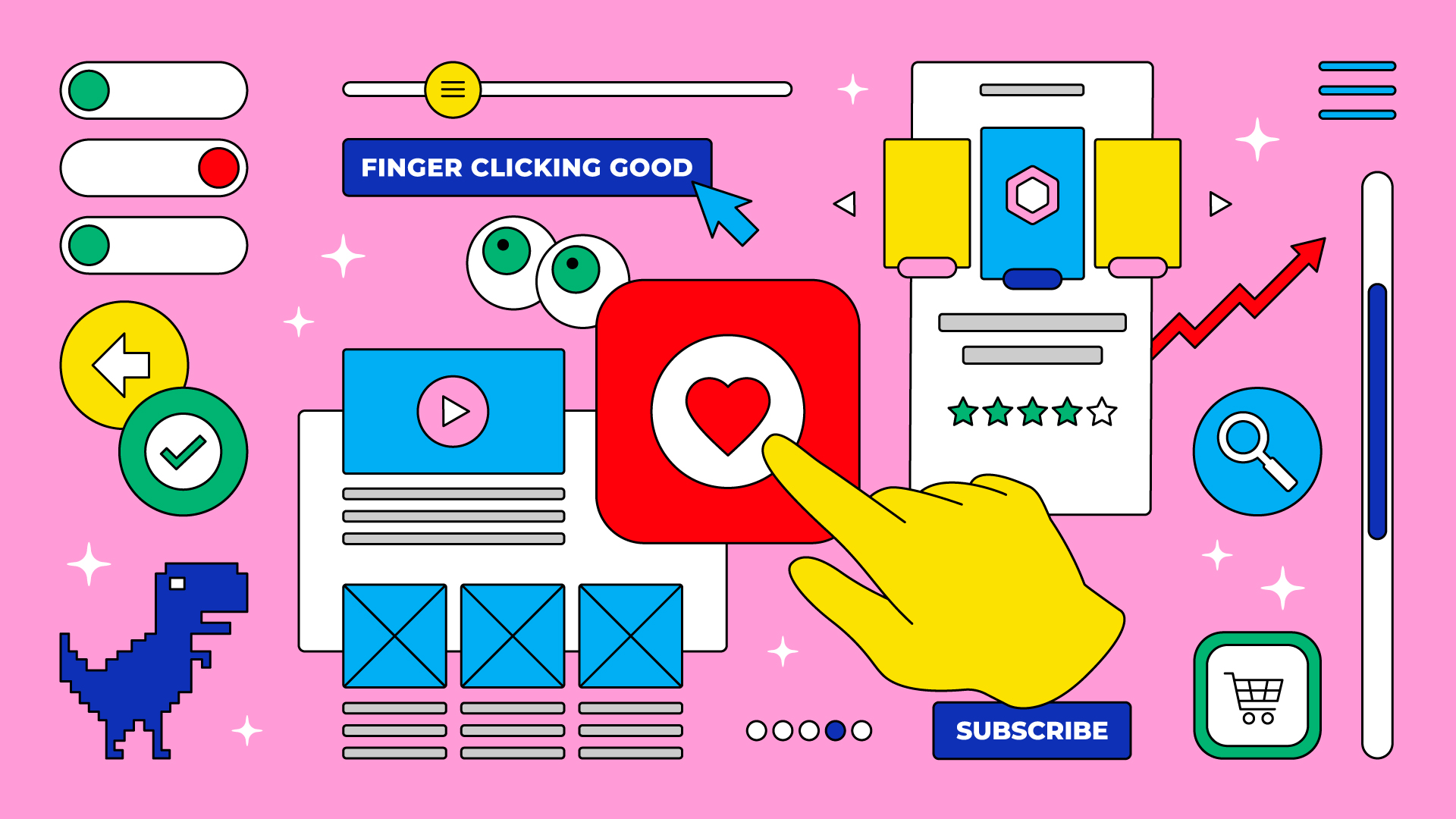Three common misconceptions about the graphic design process
The user-centred design methodology is the best way to produce optimal digital experiences, but it's not without risks. Here's some lessons we've learned about how to get the most out of the process.
SEO is one of the most viable and cost-effective ways to reach customers in key moments. From ranking in search engines to increasing exposure across social media channels, SEO remains crucial for brand visibility and paving the way for new business opportunities. According to research, 68% of online experiences begin with a search engine. That’s why SEO matters so much when designing a new website - each feature needs to be carefully crafted with search engines in mind.
When it comes to building purposeful and meaningful experiences that solve a problem and elicit an emotional response, SEO and design should work in tandem. Experience design is the process of creating seamless experiences for customers; it’s an interdisciplinary approach that requires an understanding of customer needs, technology, and user-centred products. However, top-performing websites incorporate both SEO and UX-focused web design practices. The experience of a website is all about providing users with the best possible value and ensuring they keep coming back. Read on to learn more about the power of web design and seo.
Create user-first content
One of the most important ways to maximise the performance of your brand with SEO and design is by producing user-first content. This is content that is highly relevant, useful, and engaging and provides a great on-page experience. Google’s helpful content update, released in 2022, was designed to reward websites that produce content specifically to help and inform people.
It’s now more important that businesses create content that informs, encompasses influential brand messaging and portrays a positive sentiment around the brand. By creating SEO-led content and incorporating design best practices, brands can maximise performance through the enablement of smooth and easy access at every stage of the buyer’s journey.
Quality user-first content also contributes to the overall design experience, as it helps customers understand different products and services. With user-first content, businesses deliver a strong digital presence, while at the same time creating visually appealing, search-friendly websites.
Information architecture
Information architecture is a crucial part of user experience design and SEO. It’s the process of structuring and organising information on websites to ensure optimal usability, and so that they can be easily found in search engines. When designing any digital product or website, it must be easy for users to quickly find and scan the information they’re looking for.
It’s about planning and organising the entire structure of a website and simplifying complex information for users. Information architecture covers the top navigation menu, sidebars, category pages, page structure, CTAs, and internal links. All of this enables customers to easily interact with your brand before completing a goal or progressing to a different stage down the funnel. In the organic journey toward conversion, information architecture and SEO complement each other perfectly, because the goal of both is discoverability. They pave the way for users to be able to navigate from search results to a page on the website that meets their needs in a structured way.
Site speed
The speed of your site is another critical factor of SEO. Certain design elements can slow a brand’s load time, resulting in a poor user experience and higher bounce rates. This can include large unoptimised images, flash content, plugins, and animation effects. Another factor that can slow down a website is if the design of a page allows consumption only after the content fully loads.
A fast-loading website encourages visitors to remain on your website, which will have a positive effect on your search rankings and can lead to higher conversions. Page speed is one of the most important components of any website and with the right design elements and optimisation, brands can maintain and improve performance.
Mobile friendliness
Streamlined experiences across devices are hugely important to a brand’s identity and engagement with customers. Having a mobile-friendly design directly contributes to the search performance of a website. This means establishing a mobile-friendly web design strategy, as well as a plan for continual optimisation, both of which will ensure a website is successful in the long run.
Having a responsive web design is the key to an enhanced user experience. From the images and texts to the calls to action, brands need to build a website that’s responsive across all devices. Considering that mobile accounts for approximately half of the web traffic worldwide, brands should focus on utilising SEO and web design practices for mobile searches. Brands need to offer the best presentation of their content for a user on a mobile device, focusing on structured data and an easily accessible user experience.
Get in touch with the TMWX team
At TMWX, we incorporate both digital design and SEO drive organic visibility and performance for our brands. Our expertise spans content, performance marketing, tech SEO and design, all of which embody an integrated vision. This enables us to craft bespoke experiences for our clients to attract and engage customers. It’s experiences that move people, underpinned by our Human Understanding Lab capabilities. When we create experiences for our clients, we always ensure each web platform is SEO-optimised and features compelling content that drives organic visibility. TMWX can maximise your brand’s performance.
To find out more about our SEO and design services, contact our Divisional Head of Marketing and New Business, Steve Garside.
Experience design is the process of creating memorable and transformative experiences. It contributes to the overall strategy of reaching customers, which is always at the top of every brand’s list of priorities. Having an experience that is designed and tailored to the target audience doesn’t just help attract new customers, it nurtures existing ones across the buyer’s journey. And right now, digital transformation is driving experience design and the way consumers interact with a brand.
As digitisation has grown, customers expect interesting content, products and services that are relevant to what they’re doing at any given moment, and on the device of their choosing. That’s why brands must adapt to meet the demands of today’s market and design experiences that are truly valuable to customers in the present moment. So, how exactly does experience design elevate branding? Read on to find out.
Paving the way for quality design experiences
Experience design is a holistic approach that can be applied to any experience that solves a problem, drives behaviour, and creates an emotional response. From marketing messages to web builds and new products, experience design is an entire ecosystem that includes strategy, user experience, implementation, and maintenance.
Quality experience design means every customer touch point is considered. The best businesses can sell an entire experience to audiences, rather than just their products or brand identities. Design experiences can be a competitive advantage because today’s consumers are always seeking more meaningful interactions with brands. There’s a variety of brands that have continued to improve their customer design experiences to convey their core messages and principles:
- Nike boasts an array of in-store, product, and digital experiences, all of which are focused on the customer. Nike’s immersive “Rise” store, based in Seoul, is a high-tech shopping experience that combines the digital and the physical to create an immersive branded experience that connects customers to the store. Ultimately, Nike has positioned its brand as expressive and forward-thinking, to create a positive perception and bring in new customers.
- When it comes to customer-centric experiences, there’s been few brands more effective than Apple, which has positioned itself as a highly innovative company. Apple has continued to build products that are more advanced than previous iterations. The brand has become synonymous with technology and its products are a crucial part of people’s daily lives.
- The BMW brand has also continued to evolve over the years. BMW launched a new magazine that focuses on feature stories, with issues focusing on a single theme. In this way, BMW is providing their customers with further value to keep audiences inspired and connected to the brand. The idea was born out of a desire to engage audiences that are interested in stories focused on innovation and future changes in society. By creating a magazine, BMWis providing customers with a bespoke experience that aims to leave them feeling inspired about a positive future of technology.
Experiences have always played a key role in the automotive sector. Today, the car driving experience is the most advanced it’s ever been. Cars are no longer just hardware-driven machines, instead, they serve as a platform for digital products, apps and services. The modern car now offers on-demand and customer-centric features that provide a highly personalised vehicle experience. For example, many BMW models have an integrated personal assistant that drivers can speak to and ask questions.
While an in-car intelligent personal assistant creates a more comfortable driving experience, it also creates a stronger connection between the customer and the brand. Again, customer expectations are changing, and car features are beginning to reflect that, but more importantly, higher quality, ever-evolving customer experiences make brands like BMW that much stronger.
The business value of experience design
In the customer journey, every touchpoint should reinforce the principles and personality of the brand. Since today’s consumers have so many options, a brand’s customer acquisition strategy needs to be well-defined, meaning that the brand needs to be distinctive. Why? Because a well-crafted brand experience differentiates a business from competitors. So, the biggest value of experience design is improving the performance of a brand and enhancing the customer journey.
The purpose of user experience is to keep customers engaged and loyal to the brand or product and to create a meaningful experience. According to research, 88% of online consumers are less likely to return to a site after a bad experience. This shows just how valuable user experience is for generating interest and engagement and developing a business’s online performance.
Quality experiences are extremely important for inspiring customers and driving results, as it forms the foundations on which the values of the brand are built and delivered to the digital world.Experience design is about driving products, features, and environments to meet the needs of the customer across the buyer’s journey, which leads to more sales for the brand.
What’s the future of experience design?
As the digital landscape continues to evolve, experience design is only going to become more advanced. Experience design enables brands to take visitors on a journey that showcases their values and personality. The experience itself becomes a part of the brand and allows a customer to connect more deeply with its products and services. In the future, experience design is likely to become even more personalised and immersive.
Studies have shown that 66% of consumers expect companies to understand their unique needs, indicating just how important personalisation is for keeping customers engaged. Today’s customers no longer want generic marketing, but individually personalised, unified experiences. Moving forward, brands will need to shift to personalised design experiences that fit customer needs.
TMWX have a deep understanding and knowledge of experience design. We’re experts in helping to establish and promote brands through creative digital experiences, which is fuelled by human understanding. TMWX has worked with Broadwick Hotel and many other platforms like Yoti to create unique brand identities and user experiences. We create genuine value and business advantages for our clients.
Do you want to find out more about experience? Contact us to discover how we can help your brand shine.
Four UX design conversations you should no longer be having
Say hello
London
+44 (0)20 7349 4000
Bristol
+44 (0)117 244 0800
Follow us
Want to know more?
Give us your email address and we’ll send you useful stuff as and when we have it.
© TMW






